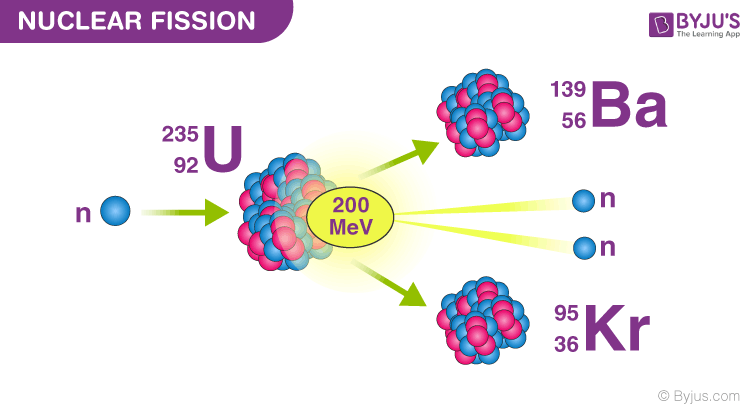Before we understand what is nuclear fission reaction, let us learn what is meant by nuclear reaction. The reaction that involves the change in the identity or characteristics of an atomic nucleus, induced by bombarding it with an energetic particle is known as a nuclear reaction. The bombarding particle may either be an alpha particle, a gamma-ray photon, a neutron, a proton, or a heavy-ion. In any case, the bombarding particle must have enough energy to approach the positively charged nucleus to within range of the strong nuclear force. Let us learn about nuclear energy and also know what is nuclear fission reaction in detail.
There are four main types of nuclear reactions as follows:
- Nuclear Fission
- Nuclear Fusion
- Nuclear Decay
- Transmutation
In the article, we will be discussing nuclear fission in detail.
Table of Contents:
- What is Nuclear Fission/a>
- What is Nuclear Energy/a>
- Fission in Nuclear Power Plants
- Difference Between Nuclear Fission and Nuclear Fusion
- Frequently Asked Questions – FAQs
What is Nuclear Fission?
When the nucleus of an atom splits into lighter nuclei through a nuclear reaction the process is termed as nuclear fission. This decay can be natural spontaneous splitting by radioactive decay, or can actually be simulated in a lab by achieving necessary conditions (bombarding with neutrinos). The resulting fragments tend to have a combined mass which is less than the original. The missing mass is what is converted into nuclear energy in the above reaction. Therefore, nuclear fission is defined as:
The process in nuclear physics in which the nucleus of an atom splits into two daughter nuclei.
 When Uranium-235 atom is bombarded with a neutron, it splits into two lighter nuclei Barium and Krypton.
When Uranium-235 atom is bombarded with a neutron, it splits into two lighter nuclei Barium and Krypton.
Examples of Nuclear Fission
- An example of nuclear fission is the splitting of Uranium-235. The equation of the reaction has been given below:
\(\begin{array}{l}_{92}^{235}\textrm{U}+_{0}^{1}\textrm{n}\rightarrow _{56}^{144}\textrm{Ba}+_{36}^{89}\textrm{Kr}+3_{0}^{1}\textrm{n}+210MeV\end{array} \) - The other example of nuclear fission is the splitting of Uranium-233. The equation of the reaction has been given below:
\(\begin{array}{l}_{92}^{233}\textrm{U}+_{0}^{1}\textrm{n}\rightarrow _{54}^{137}\textrm{Xe}+_{38}^{94}\textrm{Sr}+3_{0}^{1}\textrm{n}\end{array} \) - The splitting of Plutonium-239 is the other example of nuclear fission is given below:
\(\begin{array}{l}_{94}^{239}\textrm{Pu}+_{0}^{1}\textrm{n}\rightarrow _{54}^{137}\textrm{Xe}+_{103}^{40}\textrm{Zr}+3_{0}^{1}\textrm{n}\end{array} \)
In the next section, let us study what nuclear energy is.
What is Nuclear Energy?
All matter is made of tiny atoms. All atoms have a nucleus at their core, where most of their mass is concentrated. In specific circumstances, it is possible for this nucleus to undergo certain changes. Nuclear fusion (as the name suggests) is a process of combining small atoms, resulting in heavier atoms with more energy. Nuclear fission is splitting of the nucleus of a heavier atom into a smaller one. Both these processes release a tremendous amount of energy. And how does that happen?
Remember Einstein’s famous equation E = mc2 ?
where,
E is energy
m is mass
c is the speed of light in vacuum
Although the mass in consideration is really small, the speed of light is a large number (299792458 m/s). When this potential was realized it led to the field of harnessing nuclear energy (literally the energy in the nucleus). As per the definition of nuclear energy, it is the energy released during nuclear reactions like nuclear fission or nuclear fusion.
The good thing about nuclear energy is that it has the potential to generate a lot of energy/power without any emission of pollutants. The only disadvantage is the disposal of nuclear waste has to be done extremely carefully.
Fission in Nuclear Power Plants
We have discussed the basics of nuclear fission reactions, now let us understand what real-world applications these reactions have. One of the major applications of a fission reaction is the production of electricity via nuclear power plants. Nuclear fission is an advantageous method for producing power for several reasons.
We use nuclear reactors to generate electricity making use of the nuclear fission reaction. The heat from the nuclear fission is passed to a working fluid, which in turn runs through steam turbines. These either drive a ship’s propellers or turn electrical generators’ shafts.
Read More:
The Chernobyl Accident
Nuclear power plants cannot be thoroughly discussed without mentioning nuclear accidents. There is no tale which is more vivid or sobering than that of Chernobyl. The Chernobyl power plant, located about 80 km north of Kiev, Ukraine in the former Soviet Union, was an RBMK-1000 type reactor.
On April 26, 1986, the world’s worst nuclear accident happened at the Chernobyl plant. An explosion and fire in the No. 4 reactor sent radioactivity into the atmosphere. With the flow reduced, the cooling water in the reactor began to boil and turn to steam.
Difference Between Nuclear Fission and Nuclear Fusion
Following is the table explaining nuclear fission v/s nuclear fusion:
| Parameter | Nuclear fission | Nuclear fusion |
| Definition | Fission is defined as the splitting of a nucleus into two daughter nuclei | Fusion is defined as the combining of two lighter nuclei into a heavier one |
| Generation of energy | The amount of energy produced is huge | The amount of energy produced is relatively huge |
| Fuel | Uranium is the primary fuel that is used in the power plants | Hydrogen isotopes are the primary fuel that is used in the power plants |
Hope you have understood briefly what is nuclear fission reaction. Stay tuned with BYJU’S or subscribe to our YouTube channel to know more about various science and maths concepts.
Frequently Asked Questions – FAQs
What is nuclear fission?
What are the types of nuclear reactions?
- Nuclear Fission
- Nuclear Fusion
- Nuclear Decay
- Transmutation




Comments